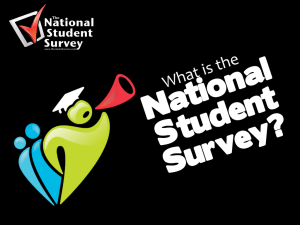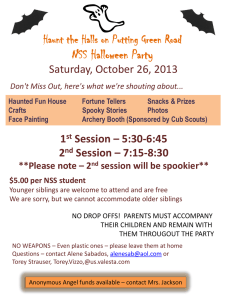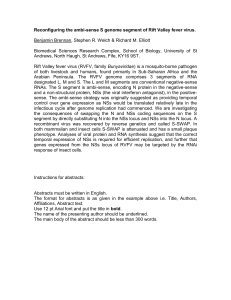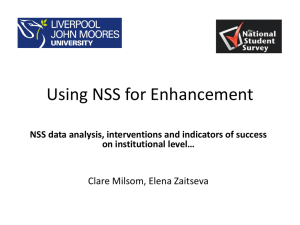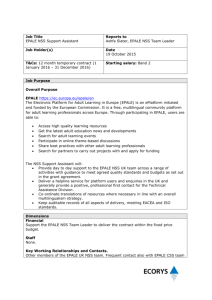Practice placements - Northumbria University
advertisement
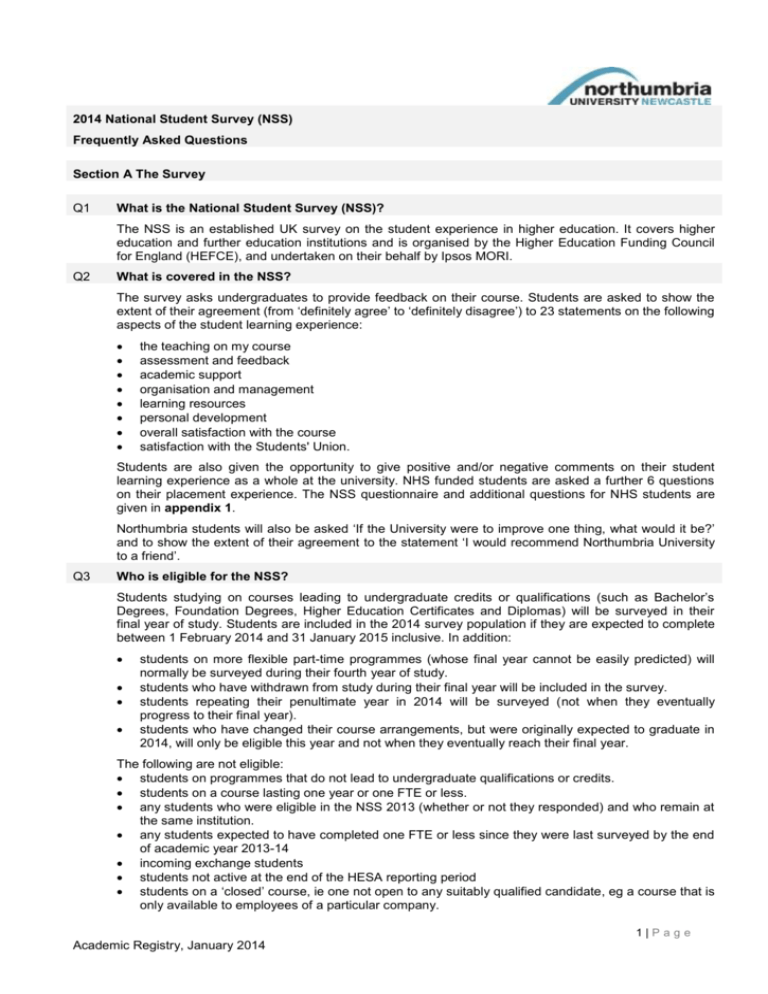
2014 National Student Survey (NSS) Frequently Asked Questions Section A The Survey Q1 What is the National Student Survey (NSS)? The NSS is an established UK survey on the student experience in higher education. It covers higher education and further education institutions and is organised by the Higher Education Funding Council for England (HEFCE), and undertaken on their behalf by Ipsos MORI. Q2 What is covered in the NSS? The survey asks undergraduates to provide feedback on their course. Students are asked to show the extent of their agreement (from ‘definitely agree’ to ‘definitely disagree’) to 23 statements on the following aspects of the student learning experience: the teaching on my course assessment and feedback academic support organisation and management learning resources personal development overall satisfaction with the course satisfaction with the Students' Union. Students are also given the opportunity to give positive and/or negative comments on their student learning experience as a whole at the university. NHS funded students are asked a further 6 questions on their placement experience. The NSS questionnaire and additional questions for NHS students are given in appendix 1. Northumbria students will also be asked ‘If the University were to improve one thing, what would it be?’ and to show the extent of their agreement to the statement ‘I would recommend Northumbria University to a friend’. Q3 Who is eligible for the NSS? Students studying on courses leading to undergraduate credits or qualifications (such as Bachelor’s Degrees, Foundation Degrees, Higher Education Certificates and Diplomas) will be surveyed in their final year of study. Students are included in the 2014 survey population if they are expected to complete between 1 February 2014 and 31 January 2015 inclusive. In addition: students on more flexible part-time programmes (whose final year cannot be easily predicted) will normally be surveyed during their fourth year of study. students who have withdrawn from study during their final year will be included in the survey. students repeating their penultimate year in 2014 will be surveyed (not when they eventually progress to their final year). students who have changed their course arrangements, but were originally expected to graduate in 2014, will only be eligible this year and not when they eventually reach their final year. The following are not eligible: students on programmes that do not lead to undergraduate qualifications or credits. students on a course lasting one year or one FTE or less. any students who were eligible in the NSS 2013 (whether or not they responded) and who remain at the same institution. any students expected to have completed one FTE or less since they were last surveyed by the end of academic year 2013-14 incoming exchange students students not active at the end of the HESA reporting period students on a ‘closed’ course, ie one not open to any suitably qualified candidate, eg a course that is only available to employees of a particular company. 1|Page Academic Registry, January 2014 Q4 How can students access the survey? In the week commencing 3 February 2014, Ipsos MORI will send a personalised email invitation to eligible students asking them to complete the survey online at www.thestudentsurvey.com. They can also access the survey link via their eLP or MyNorthumbria page, or the NSS QR code which appears on NU campaign flyers. The survey is open from 13 January 2014. Students may opt out of the survey at any time if they do not wish to take part. Students will be asked for some personal data in order to verify that they are eligible to take part. The online survey is linked to a live database of eligible students. Once a validated response has been received from a student, then they should not be contacted by Ipsos MORI again. Further activity carried out by Ipsos MORI to ensure a high response rate will be: Q5 w/c 10 February 2014, reminder email sent to those who have not responded w/c 17 February 2014, text message reminder sent to non-respondents w/c 24 February 2014, targetted postal surveys to non-responders 10 March 2014 onwards, attempts to telephone non responders (capped to avoid ‘pestering’). How is Northumbria promoting the NSS? A University campaign to jointly promote the NSS and NUSSS will be launched in the week commencing 27 January 2014. At the start of the survey, eligible students will receive an email from the Pro ViceChancellor (Learning and Teaching). Faculties will make local arrangements to raise student awareness of the survey and ensure a high response rate. Q6 Who should I ask if I have any queries on the campaign? Q7 Faculty of Arts, Design & Social Sciences Faculty of Business & Law Faculty of Engineering & Environment Faculty of Health & Life Sciences Academic Quality Jos Boys (ext 8828) Debbie Rook ( ext 4997) Helen Manns (ext 4551) Mike McGovern (ext 6320), Julie Seed (ext 3725) Sally Iles (ext 7254), Liz Morrow (ext 4290) When does NSS 2014 end? 30 April 2014 Q8 What is the NSS publication threshold? In order for results to be made publicly available, a publication threshold of 23 respondents and 50% response rate has to be met. Q9 What information is given on response rates? Response rate reports are updated regularly throughout the survey and posted on a password protected Ipsos MORI extranet. Response rates are analysed by level 3 JACS subject code, Northumbria department structure (provided to Ipsos MORI by Academic Registry) and by course. A breakdown by survey method is also provided. Academic Quality will provide weekly updates of this information to the University Executive and to Faculties. Q10 What is a JACS code? The Joint Academic Coding System (JACS) is a hierarchical subject coding system owned and maintained by the Universities and Colleges Admissions Service (UCAS) and the Higher Education Statistics Agency (HESA) and used for subject coding of provision across higher education in the UK. Find out more at http://www.hesa.ac.uk/content/view/1776/649/. Q11 Why does the sum of students studying each subject exceed the total number of students shown for the whole institution? Response rates are reported by student headcount. This means that a student on a course mapped to more than one JACS subject code would be reported as one student for each contributing subject. Q12 What is reported under the JACS subject ‘Other’? Primarily response rates for cohorts of less than 10 students (to meet data protection requirements), ie it can be the aggregation of students on a number of programmes where response thresholds cannot be met. 2|Page Academic Registry, January 2014 Section B Student List Q1 How is the list of eligible students created? The NSS list is based purely on the previous year’s HESA return. HESA run an algorithm against every student in the HESA return, and will output a list of students. This list is downloaded from the HESA submission website. As an example, the 2012/13 HESA return was used to create the 2014 NSS list. The HESA return also determines the JACS subject code/s for each included student, and mode of study. Q2 How do NSS get student contact details? Once the final NSS list is published, Academic Registry will extract student data from SITS and provide this to Ipsos MORI. This includes home/term-time addresses, mobile/landline ‘phone numbers, NU/personal email addresses. Ipsos MORI will still therefore be able to contact a student who has left and had their NU email de-activated. The Handbook of Student Regulations allows for the sharing of this personal data with Ipsos MORI for the duration of the survey. Q3 How is a student’s expected end-date worked out? As a student’s expected end date is not included in the HESA return, HESA use their algorithm to work it out. In essence, this is done by adding the length of the student’s course to their start date, plus a year adjustment taking into account the year of study that the student is currently on. This year adjustment, for example, will be used to give the correct expected end date to students who entered directly onto year 2 of a 3 year course. Q4 What happens when a student skips their sandwich placement? In this instance, HESA allow for a change in the length of the student’s course. Provided that the course length is changed against the previous Academic Year, and therefore is reported to HESA, the student should be included correctly in NSS. The procedure published in the “Administering Student Records” manual should be followed. The manual can be found here: https://intranet.northumbria.ac.uk/facultiesandservices/registry/syrp/sitsmanuals/. Q5 What happens when a student is on a full time course, but then takes up a placement year? Again, HESA allow for a change in the length of the student’s course. The transfer must be recorded against the previous academic year, following the procedure in the “Administering Student Records” manual. Q6 Why are repeating students included on the NSS list? As the NSS list is based on the previous year’s HESA return, these students cannot be excluded. For example, a student who was in year 2 of a 3 year programme in 2012/13 will be included in the 2014 National Student Survey, even if they repeat year 2 in 2013/14. There is no way of legitimately excluding these students whilst still returning valid data for the Academic Year 2012/13. As a consequence, they will be surveyed one year early and therefore excluded in the final year of study. Q7 Why are withdrawn students included on the NSS list? Any student who withdraws in the current Academic Year may be included in the NSS list, as HESA will not be aware of their withdrawal until the next HESA return is submitted in the following October. The withdrawal would have to be prior to the end of the previous Academic Year for the student to be excluded from NSS. Section C Preparation for Student List Extract Q1 Could we check the NSS list? Yes, we received a provisional list based on our initial submission of the HESA return in mid-September 2013. Faculties were then given opportunities to check and (where necessary) update the student record for final submission of the HESA Student Return in mid-October 2013. Q2 What were the timescales for making changes? Any changes were incorporated into the final HESA submission, and therefore had to be made on SITS (by Faculties) prior to the mid-October 2013 deadline. An updated list was then provided so that Faculties could check the effect of any changes made. As the NSS list is based on the HESA return, no changes can be made to the list after the HESA return has been committed. 3|Page Academic Registry, January 2014 Q3 How does NSS deal with students who are deceased? If a student is marked on SITS as deceased in the previous Academic Year, this will be reported to HESA and the student automatically excluded from the NSS list. Any student who is marked as deceased in the current Academic Year can also be excluded at the point that contact details are sent to Ipsos MORI, but this data must be on SITS by mid-November. After this point, we need to advise Ipsos MORI directly of the death of a student to avoid survey materials going out. Section C Publication of Results Q1 How are NSS results made available? NSS results are made available in three formats between August and September. Q2 Ipsos MORI produced files – detailed data for institutions to use internally, released through a dedicated secure web facility HEFCE produced files – benchmarking data for institutions to use publicly. This data will be made publicly available for the general media and population consumption. These files are provided to institutions on the NSS Results Website and is publically available via the HEFCE website Key Information Sets/Unistats data – comparison data for prospective students, parents and advisors. The Unistats website is updated in September each year and is available for the general public to access. What is the timetable for releasing results? This will be communicated by a HEFCE Circular letter, expected July 2014. Q3 How are NSS results published? Results are published in terms of ‘percentage agree’ which is calculated by taking the FPE count of students who answered ‘mostly agree’ and definitely agree’ to the specific question for the JACS subject and dividing it by the FPE count of all students answering the specific question (N/A responses are excluded). Response rates are based on a head count of respondents giving a meaningful answer to a particular question and a head count of all surveyed students for the student cohort. Q4 Do we have access to more detailed results? The password protected Ipsos MORI NSS Results website gives NU survey results in more detail, and qualitative feedback from the survey. A minimum of 10 respondents is required per cohort for NU data to be shown on this site, and there is no minimum response rate. It is also possible to compare data with other institutions (although at the higher publication threshold, 23 respondents/50% response rate). 4|Page Academic Registry, January 2014 Appendix 1 NSS Questionnaire Definitely agree Mostly agree Neither agree nor disagree Mostly disagree Definitely disagree Not applicable The teaching on my course 1. Staff are good at explaining things. 2. Staff have made the subject interesting. 3. Staff are enthusiastic about what they are teaching. 4. The course is intellectually stimulating. Assessment and feedback 5. The criteria used in marking have been clear in advance. 6. Assessment arrangements and marking have been fair. 7. Feedback on my work has been prompt. 8. I have received detailed comments on my work. 9. Feedback on my work has helped me clarify things I did not understand. Academic support 10. I have received sufficient advice and support with my studies. 11. I have been able to contact staff when I needed to. 12. Good advice was available when I needed to make study choices. Organisation and management 13. The timetable works efficiently as far as my activities are concerned. 14. Any changes in the course or teaching have been communicated effectively. 15. The course is well organised and is running smoothly. Learning resources 16. The library resources and services are good enough for my needs. 17. I have been able to access general IT resources when I needed to. 18. I have been able to access specialised equipment, facilities, or rooms when I needed to. Personal development 19. The course has helped me to present myself with confidence. 20. My communication skills have improved. 21. As a result of the course, I feel confident in tackling unfamiliar problems. 22. Overall, I am satisfied with the quality of the course. 5|Page Academic Registry, January 2014 Looking back on the experience, are there any particularly positive or negative aspects you would like to highlight? (Please use the boxes below.) Positive : Negative : Students’ Union Thinking of all the services, including support, activities and academic representation provided by the Students’ Union at your institution, to what extent do you agree with the following statement Definitely agree Mostly agree Neither agree nor disagree Mostly disagree Definitely disagree Not applicable Definitely agree Mostly agree Neither agree nor disagree Mostly disagree Definitely disagree Not applicable I am satisfied with the Students’ Union at my institution Questions for Students studying NHS Subjects Practice placements I received sufficient preparatory information prior to my placement(s). I was allocated placement(s) suitable for my course. I received appropriate supervision on placement(s). I was given opportunities to meet my required practice learning outcomes / competences. My contribution during placement(s) as part of the clinical team was valued. My practice supervisor(s) understood how my placement(s) related to the broader requirements of my course. 6|Page Academic Registry, January 2014
